Share
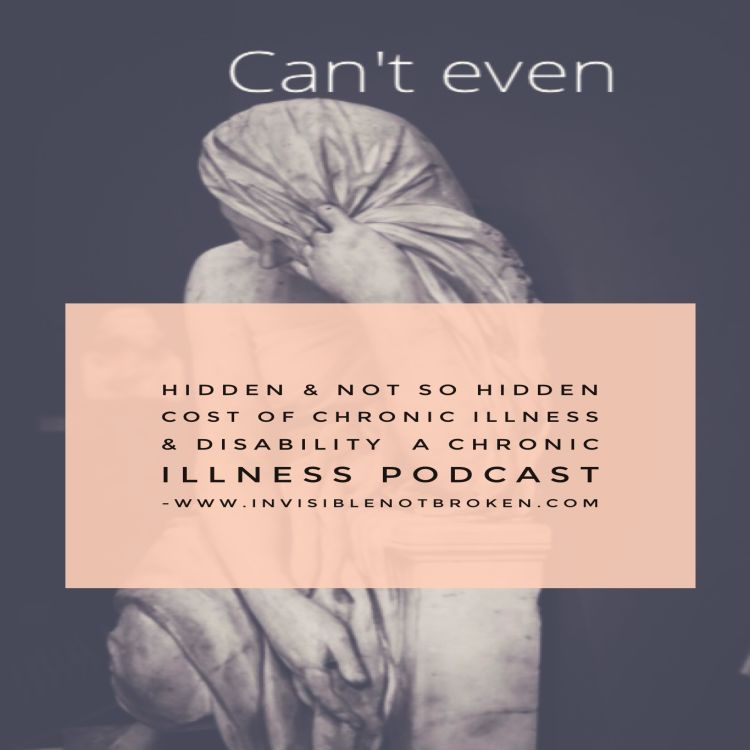
Invisible Not Broken - Chronic Illness Podcast Network
Cost of Chronic Illness A Chronic Illness Podcast
Sign up with your email address to receive news and updates.
Email Address Sign UpWe respect your privacy.
Thank you! Panel Discussion: The Cost of Having an Invisible Illness
Important Note:
According to a 2017 RAND study, as of 2014, 60 percent of Americans had at least one chronic condition, and 42 percent had multiple chronic conditions. These proportions have held steady since 2008.
As used in the RAND study, it includes any physical or mental health condition that lasts more than one year and either limits ability or requires ongoing treatment. That means high cholesterol and high blood pressure, anxiety and arthritis, heart disease and diabetes.
RAND researchers used data from a national survey on health care expenditures to compile a chartbook with the most up-to-date numbers on the cost and prevalence of such chronic conditions. Their estimates suggest that nearly 150 million Americans are living with at least one chronic condition; around 100 million of them have more than one. And nearly 30 million are living, day in and day out, with five chronic conditions or more.
Those at the highest end of the scale, with five or more conditions, represent about 12 percent of the U.S. adult population, but account for more than 40 percent of U.S. health spending, the RAND study showed.
- Financial Cost:
- Repeated trips to the doctor each with its own co-pay.
- Seeing specialists, which in addition to copays, sometimes require travel to other parts of your state or even other states.
- Tests after tests.
- Experimental procedures, not usually covered by insurance
- Second opinions
- Cost of prescriptions, even with insurance can be excessive.
- Cost of medical supplies, over-the-counter meds, and medical equipment.
- Cost of special foods (I can speak from experience that trying to find foods that are dairy-free or buying dairy-free replacements are much more expensive.)
- Taking a lot of time off work for all of these doctor appointments.
- Loss of income if you cannot work / cannot keep a job.
- Cost of alternative treatments (like acupuncture, reflexology, chiropractic care because you are desperate to find something that helps with pain) that are typically not covered by regular health insurance.
- Therapy for self and family
- Cost of more expensive everything dyson v7, cars that fit wheelchairs, wheelchairs and canes, help, ready made meals, beds that adjust, disability lawyers,
- Physical Cost:
- Harder time accessing help because people don’t believe you need it.
- Not “officially” disabled, so unable to use assistive devices everywhere. (Disneyland and my walkstool)
- Limited job prospects (many employers don’t like to make accomodations for things that they cannot see.)
- Overdoing it because you are trying to hide your disability / trying to live a normal life for just a few hours and thus paying for it for days afterwards
- Harder time doing simple tasks that you feel you should be taking care of (cleaning house, cooking, etc)
- Lost time to getting and sorting meds every week, researching treatments, being your own advocate with medical system (How many hours have you spent on the phone talking with medical professionals, Monica?)
- Emotional Cost:
- Conscious / unconscious need to act like nothing wrong, even on bad days.
- Embarrassment at asking for help or for special accommodations since your illness is not visible especially if they fear it affecting their job.
- Having to explain your illness to strangers because they don’t believe anything is wrong with you / think you are faking it.
- Strain on relationships when others have to do more because you cannot.
- Self loathing from needing someone to take care of you
- Being self-conscious because experience has taught you that people don’t believe you when you say you have an illness
- Isolation and loneliness from being home all day while friends and family are at work.
- Missed moments with family and friends because you aren’t well enough to be there. (Look at how many times we’ve tried to arrange a trip to wine country or how many times Scott and David have gone out without me because I was sick and couldn’t go.
- Depression
Links:
- https://www.rand.org/blog/rand-review/2017/07/chronic-conditions-in-america-price-and-prevalence.html
- https://themighty.com/2016/12/cost-expenses-having-chronic-disease/
- https://www.pinterest.com/pin/295267319303446311/
- http://www.mydiabeticheart.com/2017/05/16/the-costs-of-a-chronic-illness/
- https://www.sciencedaily.com/releases/2012/09/120911091100.htm
- http://thehill.com/opinion/healthcare/352032-fibromyalgia-an-invisible-disease-with-a-devastating-toll
- https://www.psychologytoday.com/us/blog/turning-straw-gold/201403/the-extra-burdens-faced-young-people-chronic-illness
- POV about costs from a woman in England: https://www.youtube.com/watch?v=qhnZVjEQKSM
More episodes
View all episodes
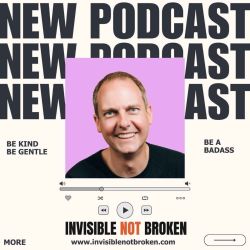
Vulnerability, Resiliency, and Advocacy with Tim Reitsma
47:06Monica Michelle is joined by consultant and podcast host Tim Reitma.Tim lives with Crohn's Disease.In this episode, Monica and Tim discuss: Tim’s resiliency through managing his Crohn’sThe importance of self-advocacy, especially in the workplace Tim’s podcast why he shares stories of those with invisible illness TIMESTAMPS00:47 - Tim's diagnosis 06:31 - How and why Tim applies self advocacy15:41 - Why Tim started his podcast22:42 - Invisible condition etiquette31:00 - What HR can do better for employees with invisible illness39:31 - Tools Tim uses to care for his Crohn’s outside the homeThe full transcript and all links mentioned can be found on the episode page on invisiblenotbroken.com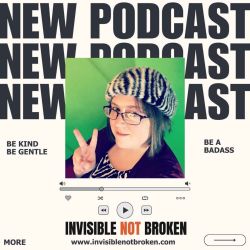
Tech and Disability: What VR Offers the Disabled Community with Sunny Ammerman
01:10:27Monica Michelle is joined by artist and disability advocate Sunny AmmermanSunny lives with Septo-optic dysplasia, panhypopituitarism, Optic Nerve Hypoplasia, and is missing a membrane in the brain called the "septum pellucidum".In this episode, Monica and Sunny discuss: Sunny’s complex disorders and how she copes with themEverything VR provides from accessible gaming, social platforms and the potential for better online education.Various VR/AR games and their gameplay Sunny’s VR support groupTIMESTAMPS00:45 - What VR/AR offers for chronically ill and disabled folks11:57 - Sunny’s conditions and how she copes with them17:55 - Features that make VR games accessible or inaccessible as well as different games and their play experiences37:13 - The social aspects of virtual gaming51:32 - What opportunities VR has for the future1:04:49 - Sunny’s VR support group The full transcript and all links mentioned can be found on the episode page on invisiblenotbroken.com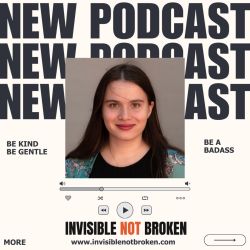
Reporting on Chronic Illness and Disability with Journalist Julia Metraux
39:16Monica Michelle is joined by Journalist Julia Metraux.Julia lives with vasculitis, mild to moderate hearing loss, and has experienced long COVID.In this episode, Monica and Julia discuss: Julia's diagnosis with vasculitis and how it influences her journalistic lensHow community impacts the mental health of those with chronic illnessHow Julia and Monica find positives and negatives in the internet spaces for chronically ill and disabled folksThe politics of how government, businesses, and celebrities influence the chronic illness community TIMESTAMPS00:32 - Julia's diagnostic journey07:02 - Julia’s work reporting on the online community of chronic illness 16:32 - The effect of Internet communities on chronically ill and disabled folks26:46 - How Julia’s illness impacts her work, both in what she writes about and how she manages her lifestyleThe full transcript and all links mentioned can be found on the episode page on invisiblenotbroken.com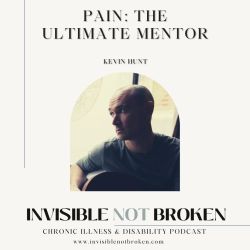
Author of “Pain: The Ultimate Mentor,” Physiotherapist Kevin Hunt
31:29Monica Michelle is joined by author & physiotherapist Kevin Hunt.Kevin lives with chronic pain.In this episode, Monica and Kevin discuss: Kevin’s philosophy of pain management as a physiotherapist who experiences chronic pain. The Hexagon Model, a life-management tool for focusing on what’s important to you.Kevin’s idea behind his new book.Using pain as a guide.TIMESTAMPS00:34 - Kevin’s work as a physiotherapist specializing in the experience of pain 06:44 - The Hexagon Model for managing your life’s needs14:00 - Putting aside the idea of a “quick fix”19:45 - Kevin’s personal experience with pain and how he uses it with patients28:44 - Kevin’s book, “Pain: The Ultimate Mentor”The full transcript and all links mentioned can be found on the episode page on invisiblenotbroken.com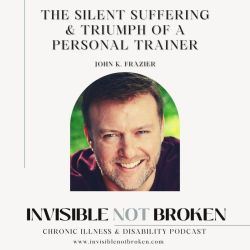
Author of “Through the Pain: The Silent Suffering & Triumph of a Personal Trainer”: John K. Frazier
28:35Monica Michelle is joined by author & personal trainer John K. Frazier.John lives with ankylosing spondylitis.In this episode, Monica and John discuss: John’s work as a physical trainer and authorChronic pain comparisonsPersonal triumphTIMESTAMPS00:50 - John’s business & diagnosis07:19 - Chronic pain olympics09:31 - Talking about & hiding a diagnosis15:09 - Personal triumph18:24 - Staying in the present23:29 - The superman complexThe full transcript and all links mentioned can be found on the episode page on invisiblenotbroken.com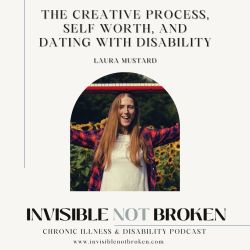
The Creative Process, Self Worth, and Dating with Disability: Laura Mustard
31:08Monica Michelle is joined by musician Laura Mustard.Laura lives with VATER syndrome.In this episode, Monica and Laura discuss: Laura’s inspiration for her upcoming musical EP.How Laura’s illness impacted her recent relationship & self-image.Laura’s creative process, new music, and social media pressure.TIMESTAMPS00:30 - Laura’s new EP / Monica’s recent COVID experience05:32 - Relationships with chronic illness11:20 - Image and self acceptance with disability15:32 - Laura’s creative process and current projects20:05 - Pursuing creativity despite social media attentionThe full transcript and all links mentioned can be found on the episode page on invisiblenotbroken.com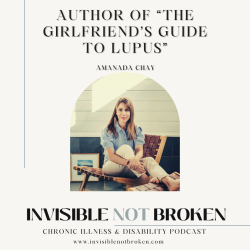
Author of “The Girlfriend’s Guide to Lupus”: Amanda Chay
30:43Monica Michelle is joined by author Amanda Chay.Amanda lives with Sjögren’s and Lupus.In this episode, Monica and Amanda discuss: Amanda’s book & diagnosisOutlooking on work & writingNavigating chronic illness with kids & familyTIMESTAMPS00:26 - Intro + The Girlfriend’s Guide to Lupus02:17 - Amanda’s diagnosis10:09 - Amanda’s outlook on writing17:11 - Navigating chronic illness with kids & family23:29 - Labels and roles26:24 - Flare reads & closing remarksThe full transcript and all links mentioned can be found on the episode page on invisiblenotbroken.com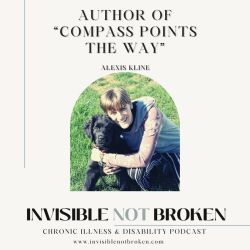
Author of “Compass Points the Way”: Alexis Kline
23:14Monica Michelle is joined by author Alexis Kline.Alexis lives with Dysautonomia.In this episode, Monica and Alexis discuss: Being a sick teenagerHaving an isolated diagnosisProductivity workflowsTIMESTAMPS00:28 - Alexis’s diagnosis & dog07:18 - Sick teenager road map10:00 - Alexis’s book & workflow16:25 - Having an isolated diagnosis20:50 - Wildlife photography, purchases The full transcript and all links mentioned can be found on the episode page on invisiblenotbroken.com
Author of “From the Sidelines to the Finish Line”: Emily Falcon
36:47Monica Michelle is joined by author Emily Falcon.Emily lives with ALCAPA.In this episode, Monica and Emily discuss: Growing up sickPost-surgery supportHaving a public bodySelf-motivation and adventuringTIMESTAMPS00:28 - Being a sick kid & Emily’s book title07:28 - Mortality10:16 - Portrayal of disability in media12:21 - Post-surgery support19:23 - Having a public body23:43 - Self-motivation29:46 - Emily’s tips for adventuresThe full transcript and all links mentioned can be found on the episode page on invisiblenotbroken.com